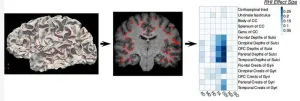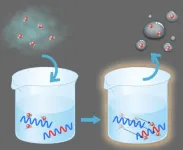(Press-News.org) Chimpanzees are known for their remarkable intelligence and use of tools, but could their cultures also evolve over time like human cultures? A new, multidisciplinary study led by the University of Zurich suggests that some of their most advanced behaviors may have been passed down and refined through generations.
In recent decades, scientists have clearly demonstrated that chimpanzees, like humans, pass on complex cultures such as tool use from generation to generation. But human culture has become vastly more sophisticated, from the Stone Age to the Space Age, as new advances have been incorporated. Chimpanzee cultures haven’t changed in the same way, which suggests that only humans have the remarkable ability to build more sophisticated cultures over time.
Scientists studying chimpanzees in the wild, however, have disputed this, suggesting that some of chimpanzees’ most complex technologies, in which they use multiple tools in sequence to extract hidden food sources, were probably built on previous knowledge over time.
Tracing genetic links
“As most chimpanzee tools, such as sticks and stems, are perishable, there are few records of their history to confirm this hypothesis – unlike human cases such as the evolution of the wheel or computer technology,” says lead author Cassandra Gunasekaram from the Department of Evolutionary Anthropology at the University of Zurich.
For the new study, a team of anthropologists, primatologists, physicists and geneticists from universities and research institutions in Zurich, St. Andrews, Barcelona, Cambridge, Konstanz and Vienna joined forces to trace genetic links between chimpanzee populations over thousands of years, using new discoveries in genetics to uncover key pieces of chimpanzee cultural history in ways never before imagined.
Early stages of cumulative culture
The authors collected information on markers of genetic similarity – genetic evidence of links between different groups of chimpanzees – as well as a range of foraging behaviors previously reported to be culturally learned, from a total of 35 chimpanzee study sites across Africa. They grouped these behaviors into those that required no tools; those that required simple tools, such as using a leaf sponge to get water from a tree hole; and the most complex behaviors that relied on a toolset.
Trading toolsets across generations
“As an example of such a toolset, chimpanzees in the Congo region first use a strong stick to dig a deep tunnel through hard soil to reach an underground termite nest,” explains Gunasekaram. “Next, they make a ‘fishing’ probe by pulling a long plant stem through their teeth to form a brush-like tip, pressing it into a point and deftly threading it down the tunnel they’ve made. They then pull it out and nibble off any defending termites that have bitten into it.”
“We made the surprising discovery that it is the most complex chimpanzee technologies – the use of entire ‘toolsets’ – that are most strongly linked across now distant populations,” says corresponding author Andrea Migliano, professor of evolutionary anthropology at UZH. “This is exactly what would be predicted if these more advanced technologies were rarely invented and even less likely to be reinvented, and therefore more likely to have been transmitted between groups.”
How female migrations spread innovation
In chimpanzees, it is sexually maturing females, rather than males, who migrate to new communities to avoid inbreeding. In this way, genes are spread between neighboring groups and then further afield over the years, centuries and millennia. The study authors discovered that it would be these same female migrations that could spread any new cultural advances to communities that lacked them.
The study also showed that when both complex toolsets and their simpler versions (i.e., mostly the components of the toolsets) occur at different study sites, the genetic markers indicate that the sites were connected in the past by female migrations. This suggests that the complex versions were built cumulatively by adding to or modifying the simple ones. “These groundbreaking discoveries provide a new way to demonstrate that chimpanzees have a cumulative culture, albeit at an early stage of development,” Migliano adds.
END
“Genetic time machine” reveals complex chimpanzee cultures
2024-11-27
ELSE PRESS RELEASES FROM THIS DATE:
Earning money while making the power grid more stable – energy consumers have a key role in supporting grid flexibility
2024-11-27
By providing flexibility services to renewable energy systems, consumers can both help in balancing power grids and receive financial benefits. Hosna Khajeh’s doctoral dissertation from the University of Vaasa, Finland, introduces new methods that enable the efficient utilisation of energy users’ flexibility resources in distribution and transmission networks.
As the use of weather-dependent renewable energy sources increases, power systems need to become more flexible to guarantee energy supply at all times. One of the necessary steps for the future is making it possible for consumers to support both national and local power grids with ...
No ‘one size fits all’ treatment for Type 1 Diabetes, study finds
2024-11-27
Factors beyond carbohydrates have a substantial influence on blood glucose levels meaning current automated insulin delivery systems miss vital information required for glucose regulation, a new study has found.
A team of researchers from the University of Bristol analysing automated insulin delivery data from people with Type 1 Diabetes (T1D) discovered that unexpected patterns in insulin needs are just as common as well-established ones.
The study, published today in JMIRx Med aimed to identify patterns in changes of insulin needs and to analyse how frequently these occur in people with T1D who use the OpenAPS, a state-of-the-art, ...
New insights into low-temperature densification of ceria-based barrier layers for solid oxide cells
2024-11-27
Solid oxide cells (SOCs), including solid oxide fuel cells (SOFCs) and solid oxide electrolysis cells (SOECs), are among the most promising energy conversion technologies due to their high efficiency and fuel flexibility. However, the high-temperature sintering required for their manufacture often leads to undesirable reactions at the electrolyte and electrode interface, degrading cell performance. A thin, dense ceria-based barrier layer, typically composed of gadolinium-doped ceria (GDC), is widely used to prevent these reactions. Achieving sufficient densification ...
AI Safety Institute launched as Korea’s AI Research Hub
2024-11-27
The Ministry of Science and ICT (MSIT), headed by Minister Yoo Sang-im, held the launch ceremony for the "AI Safety Institute" (AISI) on Wednesday, November 27, at the Pangyo Global R&D Center.
At the "AI Seoul Summit"last May, leaders from 10 countries recognized safety as a key component of responsible AI innovation and emphasized the importance of establishing AI safety institutes and fostering global collaboration for safe AI. President Yoon Suk Yeol also expressed his commitment, stating, "We will work towards establishing an AI safety institute in Korea and actively participate ...
Air pollution linked to longer duration of long-COVID symptoms
2024-11-27
Exposure to air pollutants (PM2.5 and PM10) is associated with an increased risk of persistent long-COVID symptoms, partly due to its impact on the severity of the acute infection. This is the main conclusion of a study led by the Barcelona Institute for Global Health (ISGlobal), a centre supported by “la Caixa” Foundation, in collaboration with the Germans Trias i Pujol Research Institute (IGTP), and published in Environmental Health Perspectives.
Long-COVID is a heterogeneous condition in which symptoms like fatigue, breathlessness, and cognitive issues persist for months after ...
Soccer heading damages brain regions affected in CTE
2024-11-27
CHICAGO – Soccer heading may cause more damage to the brain than previously thought, according to a study being presented next week at the annual meeting of the Radiological Society of North America (RSNA).
Heading is a widely used technique in soccer where the players control the direction of the ball by hitting it with their head. In recent years, research has been done that suggests a link between repeated head impacts and neurodegenerative diseases, such as chronic traumatic encephalopathy (CTE).
“The potential effects of repeated head impacts in sport are ...
Autism and neural dynamic range: insights into slower, more detailed processing
2024-11-27
A new study has linked distinct neural and behavioral characteristics in autism spectrum disorder to a simple computational principle. Centered on the “dynamic range” of neurons, which reflects how gradually or sharply they respond to input, the study suggests that individuals with autism spectrum disorder have an increased dynamic range in their neuronal response, resulting in a more detailed but slower response to changes. This research defies previous descriptions of ASD as a “broken cog in the machine” and provides a deeper, richer account of the computational basis of ASD.
[Hebrew University of Jerusalem]– Researchers Dr. Yuval Hart and Oded ...
AI can predict study results better than human experts
2024-11-27
Large language models, a type of AI that analyses text, can predict the results of proposed neuroscience studies more accurately than human experts, finds a new study led by UCL (University College London) researchers.
The findings, published in Nature Human Behaviour, demonstrate that large language models (LLMs) trained on vast datasets of text can distil patterns from scientific literature, enabling them to forecast scientific outcomes with superhuman accuracy.
The researchers say this highlights ...
Brain stimulation effectiveness tied to learning ability, not age
2024-11-27
As we age, our cognitive and motor functions deteriorate, which in turn affects our independence and overall quality of life. Research efforts to ameliorate or even completely abolish this have given rise to technologies that show a lot of promise.
Among these is non-invasive brain stimulation: a term encompassing a set of techniques that can affect brain functions externally and noninvasively, without the need for surgery or implants. One such promising technique, in particular, is anodal transcranial direct current stimulation (atDCS), which uses ...
Making a difference: Efficient water harvesting from air possible
2024-11-27
Harvesting water from the air and decreasing humidity are crucial to realizing a more comfortable life for humanity. Water-adsorption polymers have been playing a key part in atmospheric water harvesting and desiccant air conditioning, but desorption so that the polymers can be efficiently reused has been an issue. Now, Osaka Metropolitan University researchers have found a way to make desorption of these polymers more efficient.
Usually, heat of around 100°C is required to desorb these polymers, but Graduate School of Engineering student Daisuke Ikegawa, Assistant Professor Arisa Fukatsu, ...



